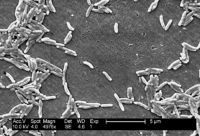Campylobacter fetus subspecies venerealis
| This article is still under construction. |
Campylobacter fetus, has the subspecies fetus and venerealis, belonging to the genus Campylobacter. Campylobacter fetus subsp. venerealis causes venereal infection in cattle and infertility in female cattle. The bacteria is found in glandular crypts of prepuce of bull with no clinical signs. Bulls are therefore known as carriers. It causes catarrhal inflammation in the female genital tract. Endometritis prevents implantation until the infection is cleared and causes early embryonic death and occasionally sporadic abortion. The cow may remain infertile for 3-5 months before immunity develops, which then lasts 4-5 years. Effective immunity includes induction of IgA in the vagina and IgG in the uterus. The bacteria may persist in the vagina and be transmitted to bulls.
Diagnosis
A fluorescent antibody test on genital discharges from the bull or cow can be diagnostic. A vaginal mucus agglutination test can be done. An ELISA to IgA antibodies in vaginal mucus after an abortion can be done in the cow, or PCR for detection in semen.
Treatment
Dihydrostreptomycin intrauterine for cows and systemically or topically for bulls. A vaccination of bacterin in oil adjuvant can also be done.
